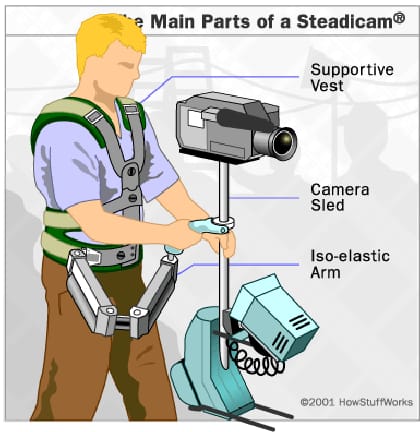
Steadicam or Gimbal: Mahesh Muthuswami
May 07 2020
Views: 1356
steadicam or Gimbal
Being able to move the camera , during a shot ,gives a lot of freedom to any filmmaker.
Every camera movement has a meaning and induces different feelings in the audience mind.
Filmmakers are constantly on the lookout for tools which help them to move the camera. The choice
of the tool, greatly influences the blocking and the kind of shot design possible.
A track and trolley is a classical grip item which is used to move the camera. A crane on the track ,adds one more dimension of craning up or down
during the shot. In the history of filmmaking , some extremely wonderful shots and long takes have
been filmed using this simple , Track and Trolley.
The final , 6 min long take of Andrei Tarkosvky’s Film ‘Sacrifice ‘ ( 1986 ) , is one such , to use the track very effortlessly to an exemplary effect.
But there are lot of places , where it is typically not possible to lay a track. And the the track , limits the nature of the camera movement very much.
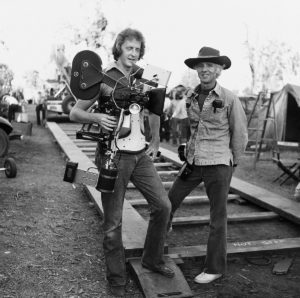
A hand held mode , lets the Cinematographer , to freely move around & capture the scene and do a blocking , which is more freewheeling. John Abraham’s Malayalam film ‘ Amma Ariyan ‘( 1986 ) ,took this approach , almost throughout the film.That film’s central theme of search and journey ,was ably expressed by the handheld approach ,with its inherent shakes and jerks. But this aesthetic might not be appropriate for all films.If we can , free wheel all around minus these shakes and jerks ? The answer is the Steadicam.

An invention by Garret Brown , in 1975 , it forever changed how movement shots are designed.It’s a mechanical solution and it relies on inertia. The part that holds the camera — the sled — also holds the monitor and batteries.
The Steadicam operator wears a vest to distribute the weight to his or her shoulders and hips, and connects the camera sled to an Iso-elastic arm(with a series of springs) that isolate his movements from the camera.A Steadicam fully immerses the audience inside the narration , allowing them to make more emotional connections with the characters.
Bound for Glory ( 1976 ) , by Hal Ashby , was the first film to use a Steadicam. Then films like Rocky ,Stanley Kubrick’s ‘ The Shining ‘ and Martin Scorsese’s ‘ Goodfellas ‘ , made very good use of Steadicam.
In India , Ram Gopal Varma’s telugu film ‘ Shiva ‘was the first one to boldly use a Steadicam , most notably for the action sequences. After the stupendous success of Shiva , the demand wassuch that ,atleast 7 or 8 Steadicams were quickly imported.
Coming to Tamil films , Maniratnam’s Roja , was one of the first to use a Steadicam shot very effectively. The long take of the point of view shot of someone approaching the terrorist’s hideout ; It was like the camera was floating , buttery smooth, turning at the corners , crossing all the hurdles.One has never seen , a moving shot with such an amazingly smooth flow , adding to the mystery of the revealing of the terrorist hideout.
Since then , the Steadicam , has become an indispesable piece of equipment , for complex camera movements and changed the way shots were made. Quick pans and tilts could be easily perfomed. Many Action choreographers also became very fond of it and used extensively in action sequences. It became a very reliable piece of equipment.
Alexander Sokurov’s ‘ Russian Arc ‘ ( 2002 ) , a 92 min long , single continuous shot film , was purely possible because of a Steadicam and a Digital Camera only. Steadicam also had its limitations , in the sense ,basically it could be either in a high-mount for roughly eye level or on a low-mount , where the camera is almost very close to the ground , while moving. But it was not possible , to move the camera from the ground level , to say an eye level or vice versa, during the shot.
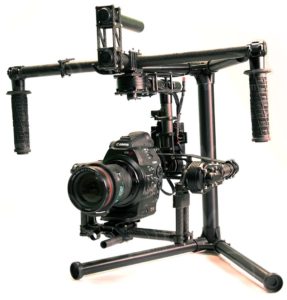
Around 2013 , FreeFly systems introduced its digital Gyro-stabilised handheld Gimbal range called the MOVI 10. It was very easy to use , almost like in a handheld mode and one can learn to use it in few minutes. The plus points were its lightweight and versatility.
MOVI 10 is an electronic and digital system. The camera gimbal works by measuring the camera’s position hundreds of times per second, and when it detects a movement, it engages brushless motors to move an equal degree in the opposite direction, thereby negating the shake.
So , now it is possible to move the camera any which way you want , from high to low , follow , jump whatever movement it could be. The MOVI 10 will stabilise it beautifully.But these first generation of Gimbals , were not very responsive to quick or swift movements. So, framing became a concern , in following fast or quick movement shots And they required , more time to mount and balance the cameras. And every lens change would require a re-balancing.
Couple of years later , Freefly introduced , new models overcoming these hiccups. And most importantly , the intuitive remote camera controller called ‘ Mimic ‘. That changed the game.With the launch of Mimic , evolved a new working style called the Dual Operator Mode ; now the image framing and camera operating are split ,separately. This gave a huge control to the Cinematographer , in framing, unlike in a Steadicam , where the framing could be done only by the Steadicam Operator.
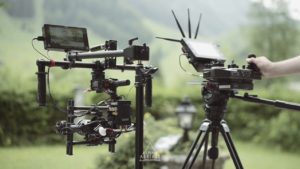
Here , the Gimbal operator can move the camera physically , whereas the precise framing could be controlled by the Cinematographer , who will be at the Mimic ; while communicating with the Gimbal operator, through a walkie. The Mimic could be easily mounted on a Tripod , akin to operating a camera on the tripod.
Another huge plus point of a handheld Gimbal , is that , for some extremely complex camera movements , the Gimbal , could be passed on during the shot from one operator to another operator . Another popular Handheld Gimbal is Ronin 2 , made by DJI. Its a stronger stabilizer for larger payloads and fast movements.
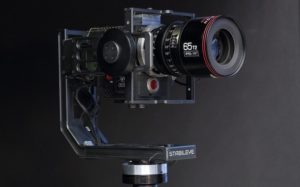
Recently another stabiliser Stabileye , from UK has caught lot of attention. StabilEye is not just a gimbal. Its a very small stabilized head that can be used as a handheld shooting platform and across different platforms like crane , cables or moving vehicles , with absolutely perfect stability.
Next , stepping up a bit , what if one combines the best of a mechanical solution like a Steadicam and
the versatility of a handheld Gimbal ?
Hybrid systems that combine elements from both stabilizers — a gimbal on a Steadicam like an arm ,have appeared in recent times. Currently , they are
more expensive and need much longer time to setup. But can deliver shots that were once thought impossible. Like starting from almost the ground
level and effortlessly going up above the eye level during the movement .
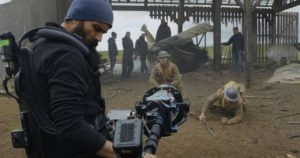
ARRI has such a hybrid system called the Trinity that can be used to capture some amazing shots.
Big budget Tamil films have already started using ARRI Trinity now.
In the recent academy award winning film ‘ 1917 ‘ ,
Roger Deakins has extensively used both the StabilEye and the ARRI Trinity to capture those awe-inspiring , immersive camera movements.
The versatility and portability of StabilEye was also put to very good use , in the climactic shot .
The camera is lifted off a 50 foot Technocrane booming across the trench and then it is hooked onto another technocrane which is mounted on a
tracking vehicle which moves forward capturing the artist running for more than a quarter of a mile
What a feat !
So, the future of camera movement is very clear.Gyro-stabilising and remote- camera control, and even autonomously operating technology, are here to takeover and the kind of shots possible , will only become more and more astounding.
Mahesh Muthuswami
Cinematographer/ faculty
x
^
